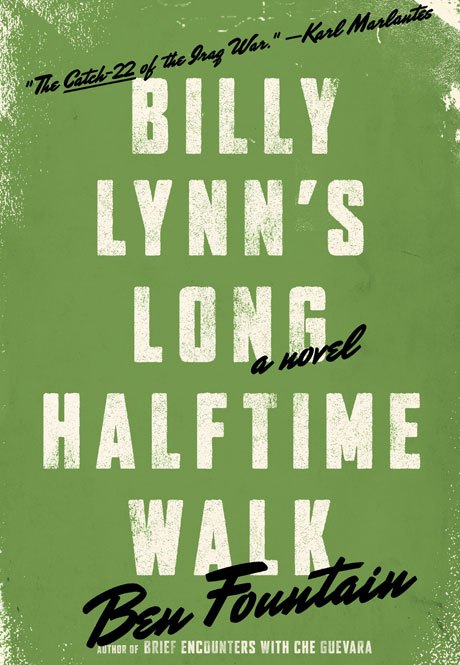Ben Fountain’s new novel Billy Lynn’s Long Halftime Walk was recently named a (top five) finalist for the National Book Award for fiction, and boy, can I see why. I found it a great example of what “literary fiction” can do so well, that screenwriting can’t — and a nice case study for the similarities and differences between the two forms.
I think “commercial fiction” (such as mystery novels, romance, etc.) tends to resemble screenwriting pretty closely, in terms of most of the principles I talk about on this site. “Literary fiction” can be another thing altogether.
Like many contemporary books of the latter type, at first glance, the one doesn’t seem to me a good candidate for a film adaptation (and I don’t mean that as any sort of criticism).
But the story does deal, in part, with the possible “film adaptation” of the true story that the main character experienced.
He (Billy Lynn) is a 19-year-old Iraq war veteran, whose “Bravo” squad is being feted on a PR tour of the home front, after an incident in which Billy played a key heroic role, despite the loss of a comrade and mentor of his, who still haunts him.
Specifically, the group of young soldiers are guests at a Thanksgiving Day Dallas Cowboys football game, and the “story” takes place almost entirely at the game, with some subjective flashbacks to what got Billy there — especially experiences in Iraq, and a recent visit to his family home in Texas before the game.
But really the focus is not so much on “what happens” during this game, as what’s going on in Billy’s head. And here is where the power of great fiction to bring to life a character’s inner thoughts, emotions, memories and perceptions (through language) achieves what screenwriting isn’t really designed to do.
It’s that inner life that captures the reader — the interpretations Billy subjectively makes of the surreal experiences he encounters at this football game. It’s about what he goes through as he considers the people and spectacle around him, and his own tormented innocence and confusion about what life has in store for him.
It’s not so much about “what happens,” then, for much of the book. It’s more about how Billy perceives what is happening. This means there’s fewer story turns and complications than you’d have in a movie. I would say it doesn’t even have the typical Catalyst or Inciting Event we talk about in screenwriting — where a clear problem emerges early on, that the main character feels must be solved. And which he then actively pursues solving, while dealing with escalating conflicts and difficulties in the process.
But what it does do, similar to great screenplays and on a different level than they ever could, is put us inside the skin of a unique individual to the point where we become him, feel for him deeply, and want desperately for him what he wants for himself.
As I advocate doing with all main characters, the writer makes us completely get who he is, what he wants, how he feels, and what he hopes to have happen. It’s told entirely from his perspective, from beginning to end, and we look “at” the other characters “through” him — something I often note is a key attribute of great screenwriting, as well.
Eventually, the power of that emotional connection to Billy wins the reader over. So when things finally start “happening” for him — increased conflicts, goals, complications and stakes (and the emotions that go with them) — we are entirely with him, completely invested. Or at least I was
Mostly the book is a satire of our contemporary society, and how it looks at and deals with things like young war heroes in the context of an NFL halftime show. Ultimately, I think it fits nicely in what Save the Cat would call the “Institutionalized” genre, where an individual’s relationship to a larger group is the main thing being explored.
The big question, in the end, is whether that character is going to stay part of that “institution,” with all its costs and benefits. He might surrender his individuality to it (as in The Godfather or One Flew Over the Cuckoo’s Nest), or he might try to escape it, or even destroy it (as in Wall Street or Goodfellas).
I always think great stories have one big question that the audience needs to care about the answer to. There’s one main thing that they’re waiting to see how it will turn out.
One main way of determining how successful a piece of writing is, is to ask how much you care (as a reader or viewer) about the answer to that question.
Whether you’d call this “literary” or “commercial” — and whether it will ever be the basis for a screenplay or not — I’d have to say this book achieves that at the highest possible level.


Erik, I always find your posts interesting and insightful. This is one of your best.